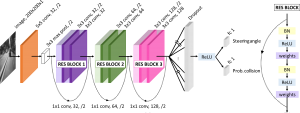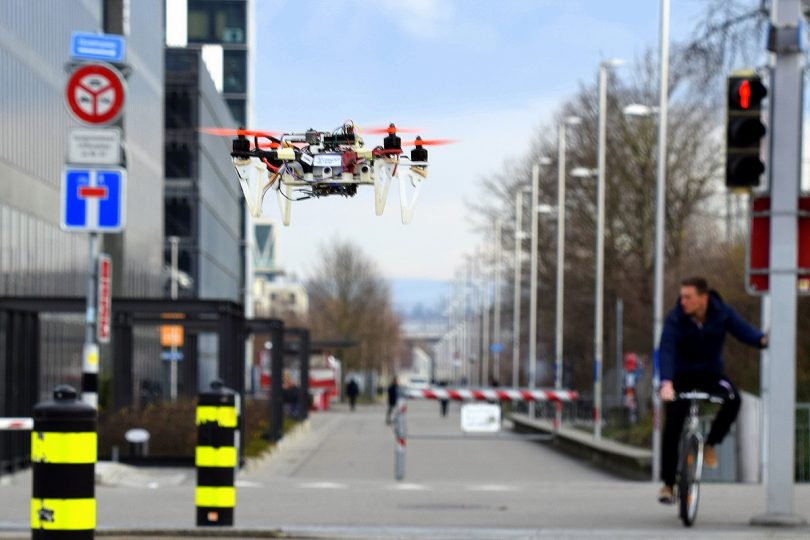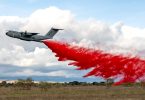University of Zurich UZH scientists developped the convolutional neural network DroNet
Civilian drones are soon expected to be used in a wide variety of tasks, such as aerial surveillance, delivery, or monitoring of existing architectures. Nevertheless, their deployment in urban environments has so far been limited. Indeed, in unstructured and highly dynamic scenarios drones face numerous challenges to navigate autonomously in a feasible and safe way. So it is published in the paper DroNet: Learning to Fly by Driving.
In contrast to the traditional map-localize-plan methods, the paper explores a data-driven approach to cope with the above challenges. To do this, University of Zurich UZH proposes DroNet, a convolutional neural network that can safely drive a drone through the streets of a city.

DroNet (IEEE RAL’18) is a convolutional neural network that can safely drive a drone through the streets of a city.
Designed as a fast 8-layers residual network, DroNet produces, for each single input image, two outputs: a steering angle, to keep the drone navigating while avoiding obstacles, and a collision probability, to let the UAV recognize dangerous situations and promptly react to them.
But how to collect enough data in an unstructured outdoor environment, such as a city?
Clearly, having an expert pilot providing training trajectories is not an option given the large amount of data required and, above all, the risk that it involves for others vehicles or pedestrians moving in the streets. Therefore, the UZH scientists propose to train a UAV from data collected by cars and bicycles, which, already integrated into urban environments, would expose other cars and pedestrians to no danger. Although trained on city streets, from the viewpoint of urban vehicles, the navigation policy learned by DroNet is highly generalizable. Indeed, it allows a UAV to successfully fly at relative high altitudes, and even in indoor environments, such as parking lots and corridors.
Description of the DroNet algorithms
DroNet (IEEE RAL’18) is a convolutional neural network that can safely drive a drone through the streets of a city. In unstructured and highly dynamic scenarios drones face numerous challenges to navigate autonomously in a feasible and safe way. Due to the danger that flying a drone can cause in an urban environment, collecting training data results impossible. For that reason, DroNet learns how to fly by imitating the behavior of manned vehicles that are already integrated in such environment.
It produces a steering angle and a collision probability for the current input image captured by a forward-looking camera. Then, these high-level commands are transferred to control commands so that the drone keeps navigating, while avoiding obstacles.
DroNet is both versatile and efficient. First, it works on very different environments, both indoor and outdoor, without any initial knowledge about them. Indeed, with neither a map of the environment nor retraining or fine-tuning, our method generalizes to scenarios completely unseen at training time, including indoor corridors, parking lots, and high altitudes. Second, DroNet was designed to require very little computational resource compared to most of the existing deep convolutional networks. This allows real-time performance, even on a CPU.
The paper: A. Loquercio, A.I. Maqueda, C.R. Del Blanco, D. Scaramuzza: DroNet: Learning to Fly by Driving, IEEE Robotics and Automation Letters (RA-L), 2018.
More information: Website
Related article: – Cargo drone for military purpose developed in China





